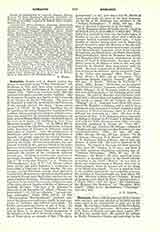

Romanus, SAINTS.—(1) A Roman martyr Romanus is mentioned in the “Liber Pontificalis” (ed. Duchesne, I, 155) with three other ecclesiastics as companions in the martyrdom of St. Lawrence (August 10, 258). There is no reason to doubt that this mention rests upon a genuine ancient tradition. Like St. Lawrence Romanus was buried in the Catacomb of the Cyriaca on the Via Tiburtina. The grave of St. Romanus is explicitly mentioned in the Itineraries of the seventh century (De Rossi, “Roma sotterranea”, I, 178-9). In the purely legendary Acts of St. Lawrence, the ostiary Romanus is transformed into a soldier, and an account in accordance with this statement was inserted in the historical martyrologies and in the present Roman Martyrology, which latter places his feast on August 9 (cf. Duchfourcq, “Les Gesta Martyrum romains” I, 201).
(2) In 303 or 304, at the beginning of the Diocletian persecution, a deacon called Romanus of Caesarea in Palestine suffered martyrdom at Antioch. Upon the proclamation of Diocletian‘s edict he strengthened the Christians of Antioch and openly exhorted the weaker brethren, who were willing to offer heathen sacrifices, not to waver in the Faith. He was taken prisoner, was condemned to death by fire, and was bound to the stake; however, as the Emperor Galerius was then in Antioch, Romanus was brought before him. At the emperor’s command the tongue of the courageous confessor was cut out. Tortured in various ways in prison he was finally strangled. Eusebius speaks of his martyrdom in “De martyribus Palestin.”, c. ii. Prudentius (“Peristephanon”, X in “P.L.”, LX, 444 sqq.) relates other details and gives Romanus a companion in martyrdom, a Christian by name Barulas. On this account several historians, among them Baronius, consider that there were two martyrs named Romanus at Antioch, though more likely there was but the one whom Eusebius mentions. Prudentius has introduced legendary features into his account, and his connection of the martyrdom of Barulas with that of Romanus is probably arbitrary. The feast of St. Romanus is observed on November 18 [cf. Allard, “Histoire des persecutions”, IV, 173 sq.; Quentin, “Les martyrologes historiques” (Paris, 1908), 183-5].
(3) The “Martyrologium Hieronymianum” mentions martyrs of this name at several dates, chiefly in large companies of Christians who suffered martyrdom. No further particulars are known of any of them.
(4) A holy priest named Romanus labored in the district of Blaye, in the present French department of the Gironde, at the end of the fourth century. Gregory of Tours gives an account of him (“De Gloria confessorum”, e. xlv), and relates that St. Martin of Tours made ready the grave of the dead Romanus. An old life of St. Romanus was published in the “Analecta Bollandiana”, V (1866), 178 sqq. The feast of the saint is observed on November 24.
(5) St. Romanus, Abbot of Condat, now St. Claude in the French Jura, b. about 400; d. in 463 or 464. When thirty-five years old he went into the lonely region of Condat to live as a hermit, where after a while his younger brother Lupicinus followed him. A large number of scholars, among whom was St. Eugendus, placed themselves under the direction of the two holy brothers who founded several monasteries: Condat (now Saint-Claude), Lauconne (later Saint-Lupicin, as Lupicinus was buried there), La Balme (later Saint-Romain-de-Roche), where St. Romanus was buried, and Romainmotier (Romanum monasterium) in the canton of Vaud in Switzerland. Romanus was ordained priest by St. Hilary of Aries in 444, and with Lupicinus he directed these monasteries until his death. His feast is observed on February 28. Two lives of him are in existence: one by Gregory of Tours in the “Liber vitae patrum” (Mon. Germ. Hist.: Script. Merov., I, 663), and an anonymous “Vita Sanctorum Romani, Lupicini, Eugendi” [ibid., III, 131 sqq.; cf. Benoit, “Histoire de St-Claude”, I (Paris, 1890); Besson, “Recherches sur les origines des eveches de Geneve, Lausanne, et Sion” (Fribourg, 1906), 210 sqq.]
(6) St. Romanus, monk in a monastery near Subiaco, Italy, at the beginning of the sixth century. He aided St. Benedict when the latter withdrew into a solitary place and regularly brought Benedict bread to support life (St. Gregory the Great, “Dialogi”, II, i). Romanus later (from 523) represented St. Benedict at Subiaco, and is said to have afterwards gone to Gaul and to have founded a small monastery at Dryes-Fontrouge, where he died about 550 and was venerated as a saint. His feast is observed on May 22. A St. Romanus, who is venerated as Bishop of Auxerre on October 8, is probably identical with this Abbot Romanus whose relics were subsequently translated to Auxerre [cf. “Acta SS.”, May, V, 153 sqq.; October, III, 396 sqq.; Adlhoch in “Studien and Mitteilungen aus dem Benedictiner- and Cisterzienserorden” (1907), 267 sqq., 501 sqq; (1908), 103 sqq., 327 sqq., 587 sqq.; Leclerc, “Vie de St Romain, educateur de St Benoit” (Paris, 1893)].
(7) St. Romanus, Bishop of Rouen, date of birth unknown; d. about 640. His feast is observed on October 23. The legend of this saint has little historical value (Acta SS., October, X, 91 sqq.), and there is but little authentic information concerning him [cf. “Analecta Bollandiana” (1904), 337 sq.]
(8) St. Romanus, “the Singer”, the most important representative of rhythmic poetry in the Greek Church. According to the Greek “Menaia” he was born in Syria, was ordained deacon at Berytus, then went to Constantinople, where he became one of the clergy at the Blachernen church. The era in which he lived is not certainly ascertained; most probably, however, his residence in Constantinople was from about 515 to 556. His feast is observed on October 1. Several of his poems were edited by Pitra, “Analecta sacra”, I (Paris, 1876), 1-241 [cf. Maas, “Die Chronologie der Hymnen des Romanus” in “Byzantin. Zeitschrift” (1906), 1-44; Bardenhewer, “Patrologie” (3rd ed.), 486].
J. P. KIRSCH

